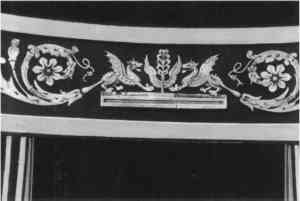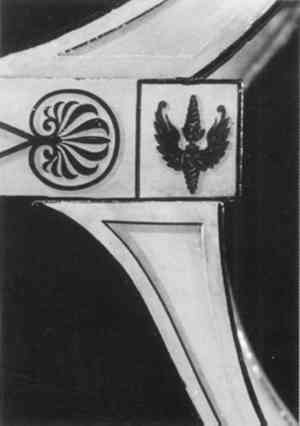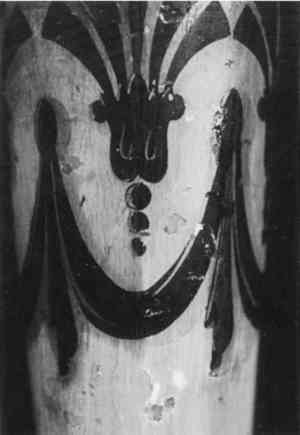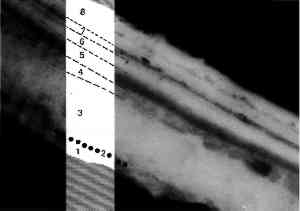THE CONSERVATION OF A PAINTED BALTIMORE SIDECHAIR (ca. 1815) ATTRIBUTED TO JOHN AND HUGH FINLAY
PETER L. FODERA, KENNETH N. NEEDLEMAN, & JOHN L. VITAGLIANO
2 EXAMINATION
Structurally the chair is in a good state, except for the seat, which has been recaned. Deep gouges in the inside surfaces of the incurvate back stiles were caused in the process of recaning. The joints are tight throughout, and it is a testimony to the superior cabinetry and craftsmanship employed by the Finlays that the chair has remained in such solid shape.
The basic decorative scheme of the chair is characteristic of the Finlay brothers' work ca. 1815. It is yellow, with elaborately painted vert antique and gilt decoration, incorporating finely rendered details in black, red, light blue, and white (fig. 6). Decorative motifs include an elongated diamond between stylized anthemions on the side rails, a frieze of mythological griffins with scrolled acanthus on the crest rail, Roman bound fasces on the front rail, and an eagle standard with a laurel wreath and torches on the stay rail of the back (Cooper 1993). It is worth noting that the central element of the crest rail design on each chair in the set is unique. Tranparent glazes were used to render shadows and give the illusion of three-dimensional relief to the painted decoration. A copper-colored metallic paint was used in the execution of some details of the fasces on the front of the seat.
Fig. 6.
Detail of frieze on crest rail of Kaufman chair, after treatment
 |
Despite the extraordinarily thick, semiopaque surface coating and extensive overpaint, the basic components of the chair's design could be more or less understood prior to treatment. Many areas of the delicate, painted trompe l'oeil relief decoration had been clumsily “enhanced” and broadly overpainted. The existing sharp, crisp, linear elements were obscured, and the relationship between rendered shadows and highlights was thrown out of balance (figs. 7, 8). This distortion was clearly evidenced on the sides of the seat and on the sides of the legs, where the shadows were reinforced with overpaint. The thin, bright white lines were barely visible beneath the discolored coatings. All of the black striping along the edges was thickly overpainted. The background of the crest rail appeared almost black.
Fig. 7.
Detail of proper left rear leg before treatment. The thick and glossy surface coating is evidenced by the reflections along the black trim onthe right edge. The white detailing is obscured by the discolored varnish.
 |
Fig. 8.
Detail of proper left front leg, showing cleaning test on the right. There are abrasions and overpaint and discolored resin pooled in the hollows of the damages. Note the clarification of the light blue highlight on the swag.
 |
In considering the treatment of the chair, we were particularly concerned as to whether the extremely heavy surface coating and extensive overpaint could be safely removed to yield a coherent decorative surface. Our cleaning tests uncovered a more vibrant overall yellow. An extraordinary clarity of surface and precision in the lines of the design stood in sharp contrast to the chair's overall appearance. Examination under the stereomicroscope and under ultraviolet light aided us in determining that the removal of surface coatings could be accomplished in two phases (figs. 9, 10). A series of layers forming a thick topcoat was removed with xylene (see fig. 11 and discussion in section 3). We found we were able to swell it by working a small area at a time with a fully charged swab. With the aid of friction, we manipulated it until it actually broke and balled up, forming a gummy, elastic skin that could be removed from the surface. The most recent retouchings were also found to be removable in the process.
Fig. 9.
Detail of cleaning test on the proper left incurvate back stile
 |
Fig. 10.
Figure 9 under ultraviolet light. This detail was taken after the topcoat was removed and after cleaning tests on a lower discolored layer. The discolored layer, which has been removed from the right side in figures 9 and 10, covered early abrasions, losses, and overpaint. It has a whitish fluorescence. The earliest coating, traces of which are seen in the cleaned area in figure 10, fluoresces a bright yellow-orange. The nonfluorescing (black) areas correspond to areas of original yellow paint surface, where the early coating had been abraded. Seen with the whitish fluorescence of the discolored layer in the uncleaned portion, the abraded areas appear light yellow.
 |
Fig. 11.
Photomicrograph of paint cross section in epi-fluorescent light with violet filter, photographed with a 20X objective. Layer 1 contains lead white (major component) and calcium carbonate (minor component). Layer 2 is a yellow-brown coating. Layer 3 is a white layer containing lead white and calcium carbonate. layer 4 is a glaze containing white lead and calcium carbonate. Layer 5 contains chrome yellow (lead chromate). Layer 6 is a fluorescent coating we believe to be an original resin coating. Layer 7 is a fluorescent coating displaying a dark upper surface.
 |
A badly discolored, stubborn layer was discovered beneath the topcoat. It covered early abrasions, losses, and overpaint and gave the surface a brownish tonality. These qualities suggested it was present at the time the chair was acquired by the Metropolitan. It was not removed in the 1967 treatment. We decided to remove this layer because it obscured the color and decorative designs of the chair. Conventional solvents and solvent mixtures proved ineffective in removing the coating. Highly polar organic solvents such as dimethylformamide and butylamine, although capable of removing the coating, did not provide the proper feel and control and had the added disadvantage of being highly irritating and toxic. Solutions of ammonium hydroxide, gelled with Carbopol 940, were effective in removing the coating while providing better working properties and affording better control (see section 4).
|





